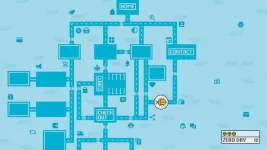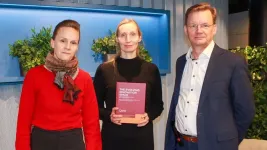(Press-News.org) The targeted treatment of brain diseases such as Alzheimer’s, Parkinson’s or brain tumours is challenging because the brain is a particularly sensitive organ that is well protected. That’s why researchers are working on ways of delivering drugs to the brain precisely, via the bloodstream. The aim is to overcome the blood-brain barrier which normally only allows certain nutrients and oxygen to pass through.
Microbubbles that react to ultrasound are a particularly promising method for this sort of therapy. These microbubbles are smaller than a red blood cell, filled with gas and have consist of a special coating of fat molecules to stabilise them. They are injected into the bloodstream together with the drug and then activated at the target site using ultrasound. The action movement of the microbubbles creates tiny pores in the cell membrane of the blood vessel wall which the drug can then pass through.
How exactly microbubbles create these pores was previously unclear. Now, a group of ETH researchers, led by Outi Supponen, a professor at the Institute of Fluid Dynamics, have been able to demonstrate for the first time how this mechanism works. “We were able to show that under ultrasound, the surface of the microbubbles loses theirits shape, resulting in tiny jets of liquid, so-called microjets, which penetrate the cell membrane,” explains Marco Cattaneo, Supponen’s doctoral student and lead author of the study which was recently published in Nature Physics.
The invisible force: liquid microjets at 200 kph
Until now, nobody knew how the pores in the cell membrane were formed because the microbubbles measure just a few micrometres across and vibrate up to several million times per second under ultrasound. This is a process that is incredibly difficult to observe and which requires a special set-up in the lab. “So far, most studies have looked at the process from above through a conventional microscope. But when you do that, you can’t see what’s happening between the microbubble and the cell,” says Cattaneo. The researchers therefore built a microscope with a magnification of 200x, which allows them to observe the process from the side, and connected it to a high-speed camera that can take up to ten million images per second.
For their experiment, they mimicked the blood vessel wall using an in-vitro model, growing endothelial cells on a plastic membrane. They placed this membrane on a box with transparent walls filled with a saline solution and a model drug, with the cells facing down like a lid. The gas-filled microbubble rose to the top automatically and made contact with the cells. The microbubbles were then set in vibration by a microsecond-long pulse of ultrasound.
The targeted treatment of brain diseases such as Alzheimer’s, Parkinson’s or brain tumours is challenging because the brain is a particularly sensitive organ that is well protected. That’s why researchers are working on ways of delivering drugs to the brain precisely, via the bloodstream. The aim is to overcome the blood-brain barrier which normally only allows certain nutrients and oxygen to pass through.
Microbubbles that react to ultrasound are a particularly promising method for this sort of therapy. These microbubbles are smaller than a red blood cell, filled with gas and have consist of a special coating of fat molecules to stabilise them. They are injected into the bloodstream together with the drug and then activated at the target site using ultrasound. The action movement of the microbubbles creates tiny pores in the cell membrane of the blood vessel wall which the drug can then pass through.
How exactly microbubbles create these pores was previously unclear. Now, a group of ETH researchers, led by Outi Supponen, a professor at the Institute of Fluid Dynamics, have been able to demonstrate for the first time how this mechanism works. “We were able to show that under ultrasound, the surface of the microbubbles loses theirits shape, resulting in tiny jets of liquid, so-called microjets, which penetrate the cell membrane,” explains Marco Cattaneo, Supponen’s doctoral student and lead author of the study which was recently published in Nature Physics.
The invisible force: liquid microjets at 200 kph
Until now, nobody knew how the pores in the cell membrane were formed because the microbubbles measure just a few micrometres across and vibrate up to several million times per second under ultrasound. This is a process that is incredibly difficult to observe and which requires a special set-up in the lab. “So far, most studies have looked at the process from above through a conventional microscope. But when you do that, you can’t see what’s happening between the microbubble and the cell,” says Cattaneo. The researchers therefore built a microscope with a magnification of 200x, which allows them to observe the process from the side, and connected it to a high-speed camera that can take up to ten million images per second.
For their experiment, they mimicked the blood vessel wall using an in-vitro model, growing endothelial cells on a plastic membrane. They placed this membrane on a box with transparent walls filled with a saline solution and a model drug, with the cells facing down like a lid. The gas-filled microbubble rose to the top automatically and made contact with the cells. The microbubbles were then set in vibration by a microsecond-long pulse of ultrasound.
“At a sufficiently high ultrasound pressure, microbubbles stop oscillating in a spherical shape and start reshaping themselves into regular, non-spherical patterns,” says Supponen. The “lobes” of these patterns oscillate cyclically, pushing inwards and outwards. The researchers discovered that above a certain ultrasound pressure, the inward-folded lobes can become so deeply sunken that they generate powerful jets, crossing the entire bubble and making contact with the cell.
These microjets move at an incredible speed of 200 kph and are able to perforate the cell membrane like a targeted pinprick without destroying the cell. This jet mechanism does not destroy the bubble, meaning that a new microjet can form with each ultrasound cycle.
Physics in the service of medicine
“An intriguing aspect is that this ejection mechanism is triggered at low ultrasound pressures, around 100 kPa,” says Supponen. This means that the ultrasound pressure acting on the microbubbles, and therefore on the patient, is comparable to the atmospheric air pressure that is around us all the time.
The researchers from Supponen’s group not only made visual observations, but also provided explanations using a range of different theoretical models. They were able to show that the microjets have by far the greatest potential for damage over the many other mechanisms that have been proposed in the past, strongly supporting the researchers’ observation that the cell membrane is pierced only when a microjet is generated. Cattaneo says, “With our lab setup, we now have a better way of observing the microbubbles and can describe the cell-microbubble interaction more precisely.” This system can also be used to investigate how new microbubble formulations developed by other researchers react to ultrasound, for example.
Supponen adds, “Our work clarifies the physical foundations for targeted administration of drugs through microbubbles and helps us define criteria for their safe and effective use.” This means that the right combination of frequency, pressure and microbubble size can help to maximise the outcome of the therapy, while ensuring greater safety and lower risk to patients. “Additionally, we were able to show that just a few pulses of ultrasound are enough to perforate a cell membrane. This is also good news for patients,” says Supponen. Conversely, the coating of the microbubbles can also be optimised for the required ultrasound frequency, making it easier for the jets to form.
“At a sufficiently high ultrasound pressure, microbubbles stop oscillating in a spherical shape and start reshaping themselves into regular, non-spherical patterns,” says Supponen. The “lobes” of these patterns oscillate cyclically, pushing inwards and outwards. The researchers discovered that above a certain ultrasound pressure, the inward-folded lobes can become so deeply sunken that they generate powerful jets, crossing the entire bubble and making contact with the cell.
These microjets move at an incredible speed of 200 kph and are able to perforate the cell membrane like a targeted pinprick without destroying the cell. This jet mechanism does not destroy the bubble, meaning that a new microjet can form with each ultrasound cycle.
Physics in the service of medicine
“An intriguing aspect is that this ejection mechanism is triggered at low ultrasound pressures, around 100 kPa,” says Supponen. This means that the ultrasound pressure acting on the microbubbles, and therefore on the patient, is comparable to the atmospheric air pressure that is around us all the time.
The researchers from Supponen’s group not only made visual observations, but also provided explanations using a range of different theoretical models. They were able to show that the microjets have by far the greatest potential for damage over the many other mechanisms that have been proposed in the past, strongly supporting the researchers’ observation that the cell membrane is pierced only when a microjet is generated. Cattaneo says, “With our lab setup, we now have a better way of observing the microbubbles and can describe the cell-microbubble interaction more precisely.” This system can also be used to investigate how new microbubble formulations developed by other researchers react to ultrasound, for example.
Supponen adds, “Our work clarifies the physical foundations for targeted administration of drugs through microbubbles and helps us define criteria for their safe and effective use.” This means that the right combination of frequency, pressure and microbubble size can help to maximise the outcome of the therapy, while ensuring greater safety and lower risk to patients. “Additionally, we were able to show that just a few pulses of ultrasound are enough to perforate a cell membrane. This is also good news for patients,” says Supponen. Conversely, the coating of the microbubbles can also be optimised for the required ultrasound frequency, making it easier for the jets to form.
Reference
Cattaneo M, Guerriero G, Gazendra S, Krattiger L, Paganella L, Narciso M, Supponen O, Cyclic jetting enables microbubble-mediated drug delivery, Nature Physics (2025), DOI: 10.1038/s41567-025-02785-0, https://www.nature.com/articles/s41567-025-02785-0
END
Precision therapy with microbubbles
2025-02-21
ELSE PRESS RELEASES FROM THIS DATE:
LLM-based web application scanner recognizes tasks and workflows
2025-02-21
A new automated web application scanner autonomously understands and executes tasks and workflows on web applications. The tool named YuraScanner harnesses the world knowledge stored in Large Language Models (LLMs) to navigate through web applications in the same way a human user would. It is capable of working through tasks in a coherent fashion, performing the correct sequence of steps as required by, for example, an online shop. YuraScanner was tested against 20 web applications, unearthing 12 zero-day cross-site scripting (XSS) vulnerabilities. The technique behind YuraScanner as well as the tool itself have been developed by researchers ...
Pattern of compounds in blood may indicate severity of gestational hypertension and preeclampsia
2025-02-21
Preeclampsia, a complication of pregnancy characterized by high blood pressure and high levels of protein in the urine (proteinuria), indicating damage to the kidneys or other organ damage, is the main cause of maternal-fetal death in Brazil and the runner-up worldwide. In a Brazilian study published in the journal PLOS ONE, the pattern of substances present in patient blood samples varied according to the severity of the preeclampsia concerned.
The findings from the study, which was supported by FAPESP, ...
How does innovation policy respond to the challenges of a changing world?
2025-02-21
Researchers from the University of Vaasa, Finland, and Kent Business School, UK, have gathered insights on innovation policy, its current status and future perspectives in their new book “The Evolving Innovation Space”. The book offers research-based insights on how innovation can best be used to drive economic change and to find solutions to global problems.
– In a changing world, where geopolitical tensions are rising and artificial intelligence is gaining ground, innovation policy must also be reconsidered from new perspectives, says Helka Kalliomäki, one of the editors.
With digital ...
What happens when a diet targets ultra-processed foods?
2025-02-21
Most dietary programs are designed to help people achieve weight loss or adhere to U.S. nutrition guidelines, which currently make no mention of ultra-processed foods (UPFs). UPFs – like chips or candy – are the mass-produced, packaged products that contain little or no naturally occurring foods. Eating UPFs is strongly associated with increased risk of diseases and early death.
Because almost no existing programs focus specifically on reducing UPF intake, researchers from Drexel University’s College of Arts and Sciences designed an intervention that included a variety of tactics to target the uniquely problematic ...
University of Vaasa, Finland, conducts research on utilizing buildings as energy sources
2025-02-21
The University of Vaasa has received funding from Business Finland for the FlexiPower research and development project, which focuses on developing and commercializing the "Building as a Battery" (BaaB) solution. The project aims to find solutions that utilize existing building infrastructure as flexible energy sources.
The goal of the FlexiPower project is to develop and commercialize a solution that enables the dynamic response of building heating and cooling systems to the needs of the power system. This innovation offers a cost-effective and scalable solution for balancing the power grid without significant initial ...
Stealth virus: Zika virus builds tunnels to covertly infect cells of the placenta
2025-02-21
Infection with Zika virus in pregnancy can lead to neurological disorders, fetal abnormalities and fetal death. Until now, how the virus manages to cross the placenta, which nurtures the developing fetus and forms a strong barrier against microbes and chemicals that could harm the fetus, has not been clear. Researchers at Baylor College of Medicine with collaborators at Pennsylvania State University report in Nature Communications a strategy Zika virus uses to covertly spread in placental cells, raising little alarm in the immune system.
“The Zika virus, which is transmitted by mosquitoes, triggered an epidemic in the Americas that began in 2015 and ...
The rising tide of sand mining: a growing threat to marine life
2025-02-21
In the delicate balancing act between human development and protecting the fragile natural world, sand is weighing down the scales on the human side.
A group of international scientists in this week’s journal One Earth are calling for balancing those scales to better identify the significant damage sand extraction across the world heaps upon marine biodiversity. The first step: acknowledging sand and gravel (discussed as sand in this publication) – the world’s most extracted solid materials by mass – are a threat hiding in plain sight.
“Sand is a critical resource that shapes the built and ...
Contemporary patterns of end-of-life care among Medicare beneficiaries with advanced cancer
2025-02-21
About The Study: This study found persistent patterns of potentially aggressive care, but low uptake of supportive care, among Medicare decedents with advanced cancer. A multifaceted approach targeting patient-, physician-, and system-level factors associated with potentially aggressive care is imperative for improving quality of care at the end of life.
Corresponding Author: To contact the corresponding author, Youngmin Kwon, PhD, email youngmin.kwon@vumc.org.
To access the embargoed study: Visit our For The Media website at this link https://media.jamanetwork.com/
(doi:10.1001/jamahealthforum.2024.5436)
Editor’s Note: Please see the article ...
Digital screen time and nearsightedness
2025-02-21
About The Study: In this systematic review and dose-response meta-analysis, a daily 1-hour increment in digital screen time was associated with 21% higher odds of myopia (nearsightedness) and the dose-response pattern exhibited a sigmoidal shape, indicating a potential safety threshold of less than 1 hour per day of exposure, with an increase in odds up to 4 hours. These findings can offer guidance to clinicians and researchers regarding myopia risk.
Corresponding Author: To contact the corresponding author, Young Kook Kim, PhD, email md092@naver.com.
To access the embargoed study: Visit our For The Media website at this link https://media.jamanetwork.com/
(doi:10.1001/jamanetworkopen.2024.60026)
Editor’s ...
Postoperative weight loss after anti-obesity medications and revision risk after joint replacement
2025-02-21
About The Study: In this cohort study using a target trial emulation, a higher proportion of weight loss after initiating anti-obesity medications within 1 year was associated with a lower risk of 5-year and 10-year revision among patients with obesity undergoing joint replacement. These results suggest that anti-obesity medication use, with relatively safe and sustainable weight loss, may be an effective strategy for improving implant survivorship of hip and knee replacements in the obese population.
Corresponding Author: To ...



